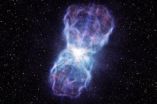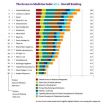(Press-News.org) According to psychological lore, when it comes to items of information the mind can cope with before confusion sets in, the "magic" number is seven.
But a new analysis by a leading Australian professor of psychiatry challenges this long-held view, suggesting the number might actually be four.
In 1956, American psychologist George Miller published a paper in the influential journal Psychological Review arguing the mind could cope with a maximum of only seven chunks of information.
The paper, "The Magical Number Seven, Plus or Minus Two. Some Limits on Our Capacity for Processing Information", has since become one of the most highly cited psychology articles and has been judged by the Psychological Review as its most influential paper of all time.
But professor of psychiatry Gordon Parker, from the University of NSW in Sydney, Australia, says a re-analysis of the experiments used by Miller shows he missed the correct number by a wide mark.
Writing in the journal Acta Psychiatrica Scandinavica, Scientia Professor Parker says a closer look at the evidence shows the human mind copes with a maximum of four 'chunks' of information, not seven.
"So to remember a seven numeral phone number, say 6458937, we need to break it into four chunks: 64. 58. 93. 7. Basically four is the limit to our perception.
"That's a big difference for a paper that is one of the most highly referenced psychology articles ever – nearly a 100 percent discrepancy," he suggests.
Professor Parker says the success of the original paper lies "more in its multilayered title and Miller's evocative use of the word 'magic'," than in the science.
Professor Parker says 50 years after Miller there is still uncertainty about the nature of the brain's storage capacity limits: "There may be no limit in storage capacity per se but only a limit to the duration in which items can remain active in short-term memory".
"Regardless, the consensus now is that humans can best store only four chunks in short-term memory tasks," he says.
###
The full discussion paper includes many exemplars of the magic of 'four'.
Professor Parker is available for interview on +61 2 93824372.
4 is the 'magic' number
A new analysis suggests 4 -- not 7 -- is the 'magic' number easily processed by the brain
2012-11-28
ELSE PRESS RELEASES FROM THIS DATE:
Biggest black hole blast discovered
2012-11-28
Quasars are the intensely luminous centres of distant galaxies that are powered by huge black holes. This new study has looked at one of these energetic objects – known as SDSS J1106+1939 – in great detail, using the X-shooter instrument on ESO's VLT at the Paranal Observatory in Chile [1]. Although black holes are noted for pulling material in, most quasars also accelerate some of the material around them and eject it at high speed.
"We have discovered the most energetic quasar outflow known to date. The rate that energy is carried away by this huge mass of material ...
Potentially toxic flame retardants found in many US couches
2012-11-28
DURHAM, N.C. -- More than half of all couches tested in a Duke University-led study contained potentially toxic or untested chemical flame retardants that may pose risks to human health.
Among the chemicals detected was "Tris," a chlorinated flame retardant that is considered a probable human carcinogen based on animal studies.
"Tris was phased out from use in baby pajamas back in 1977 because of its health risks, but it still showed up in 41 percent of the couch foam samples we tested," said Heather Stapleton, associate professor of environmental chemistry at ...
80 percent of parents interested in genetic risk assessment for siblings of children with autism
2012-11-28
Cambridge, MA (November 28, 2012)--The vast majority (80 percent) of parents with at least one child with Autism Spectrum Disorder (ASD) would pursue genetic testing if a test were available that could identify risk in a younger sibling, citing the desire for earlier identification of children at risk, earlier evaluation and intervention, closer monitoring and lessened anxiety. The findings were reported in "Parental Interest in a Genetic Risk Assessment Test for Autism Spectrum Disorders," a survey published online today in the journal Clinical Pediatrics.
The survey ...
WSU researchers use 3-D printer to make parts from moon rock
2012-11-28
PULLMAN, Wash. - Imagine landing on the moon or Mars, putting rocks through a 3-D printer and making something useful – like a needed wrench or replacement part.
"It sounds like science fiction, but now it's really possible," says Amit Bandyopadhyay, professor in the School of Mechanical and Materials Engineering at Washington State University.
Bandyopadhyay and a group of colleagues recently published a paper in Rapid Prototyping Journal demonstrating how to print parts using materials from the moon.
Bandyopadhyay and Susmita Bose, professor in the School of Mechanical ...
Treating cocaine dependence: A promising new pharmacotherapy
2012-11-28
Philadelphia, PA, November 28, 2012 – Medication development efforts for cocaine dependence have yet to result in an FDA approved treatment. The powerful rewarding effects of cocaine, the profound disruptive impact of cocaine dependence on one's lifestyle, and the tendency of cocaine to attract people who make poor life choices and then exacerbate impulsive behavior all make cocaine a vexing clinical condition.
In this battle, many candidate pharmacotherapies have been tested, but none have succeeded sufficiently to be adopted widely. Perhaps like cancer, heart disease, ...
Brain cell transplants in early 2013
2012-11-28
As part of the European study TRANSEURO, five patients with Parkinson's disease will undergo brain cell transplants at Skåne University Hospital in Lund, Sweden, in early 2013. These are the first operations of their kind in Europe for over 10 years.
The TRANSEURO study, which in Sweden is led by Lund University, is now taking a critical approach to the viability of cell therapy as a future treatment for Parkinson's disease. Can we replace cells that die as a result of our most common neurological diseases? What are the therapies of the future for neurodegenerative diseases ...
Report finds Big Pharma is doing more for access to medicine in developing countries
2012-11-28
Amsterdam, the Netherlands: The latest Access to Medicine Index, which ranks the top 20 pharmaceutical companies on their efforts to improve access to medicine in developing countries, finds that the industry is doing more than it was two years ago, with GlaxoSmithKline still outperforming its peers, but an expanding group of leaders closing the gap.
The Index, published Wednesday, found that Johnson & Johnson was one of the most dramatic risers, climbing from the middle of the field in 9th position in the 2010 Index to 2nd this year, closely behind GlaxoSmithKline. It ...
Anthropological expertise facilitates multicultural women's health care
2012-11-28
Collaboration between medical and anthropological expertise can solve complex clinical problems in today's multicultural women's healthcare, shows Pauline Binder, a medical anthropologist, who will present her thesis on 1 December at the Faculty of Medicine, Uppsala University, Sweden.
Pauline Binder has applied in-depth medical anthropological research approaches to understand clinical problems in ways not possible using only statistics. Why pregnant Somali women have an increased risk of complications even after migration has been the starting point for her fieldwork. ...
Researchers identify ways to exploit 'cloud browsers' for large-scale, anonymous computing
2012-11-28
Researchers from North Carolina State University and the University of Oregon have found a way to exploit cloud-based Web browsers, using them to perform large-scale computing tasks anonymously. The finding has potential ramifications for the security of "cloud browser" services.
At issue are cloud browsers, which create a Web interface in the cloud so that computing is done there rather than on a user's machine. This is particularly useful for mobile devices, such as smartphones, which have limited computing power.The cloud-computing paradigm pools the computational ...
Graphite experiment shines new light on giant planets, white dwarfs and laser-driven fusion
2012-11-28
An international team led by researchers from the University of Warwick and Oxford University is now dealing with unexpected results of an experiment with strongly heated graphite (up to 17,000 degrees Kelvin). The findings may pose a new problem for physicists working in laser-driven nuclear fusion and may also lead astrophysicists to revise our understanding of the life cycle of giant planets and stars.
The researchers were attempting to get a better understanding about how energy is shared between the different species of matter, especially, how it is transferred from ...
LAST 30 PRESS RELEASES:
Jeonbuk National University study shows positive parenting can protect adolescents against self-harm
Surface-engineered ZnO nanocrystals to tackle perfluoroalkyl substance contamination
This new understanding of T cell receptors may improve cancer immunotherapies
A new fossil face sheds light on early migrations of ancient human ancestor
A new immunotherapy approach could work for many types of cancer
A new way to diagnose deadly lung infections and save lives
40 percent of MRI signals do not correspond to actual brain activity
How brain-inspired algorithms could drive down AI energy costs
Gum disease may be linked to plaque buildup in arteries, higher risk of major CVD events
Contrails are a major driver of aviation’s climate impact
Structure of dopamine-releasing neurons relates to the type of circuits they form for smell-processing
Reducing social isolation protects the brain in later life
Keeping the heart healthy increases longevity even after cancer
Young adults commonly mix cannabis with nicotine and tobacco
Comprehensive review illuminates tau protein's dual nature in brain health, disease, and emerging psychiatric connections
Book prepares K-12 leaders for the next public health crisis
Storms in the Southern Ocean mitigates global warming
Seals on the move: Research reveals key data for offshore development and international ecology
Sports injuries sustained during your period might be more severe
World's first successful 2 Tbit/s free-space optical communication using small optical terminals mountable on satellites and HAPS
Can intimate relationships affect your heart? New study says ‘yes’
Scalable and healable gradient textiles for multi‑scenario radiative cooling via bicomponent blow spinning
Research shows informed traders never let a good climate crisis go to waste
Intelligent XGBoost framework enhances asphalt pavement skid resistance assessment
Dual-function biomaterials for postoperative osteosarcoma: Tumor suppression and bone regeneration
New framework reveals where transport emissions concentrate in Singapore
NTP-enhanced lattice oxygen activation in Ce-Co catalysts for low-temperature soot combustion
Synergistic interface engineering in Cu-Zn-Ce catalysts for efficient CO2 hydrogenation to methanol
COVID-19 leaves a lasting mark on the human brain
Scientists use ultrasound to soften and treat cancer tumors without damaging healthy tissue
[Press-News.org] 4 is the 'magic' numberA new analysis suggests 4 -- not 7 -- is the 'magic' number easily processed by the brain



